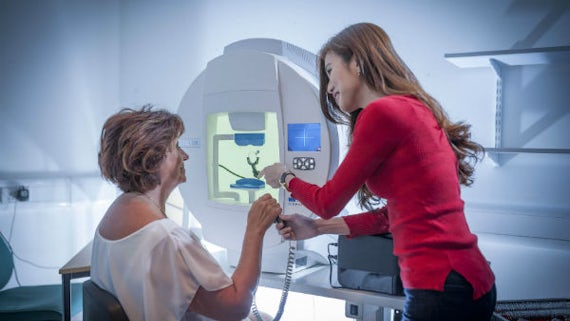Optical coherence tomography
Mae'r cynnwys hwn ar gael yn Saesneg yn unig.

Optical coherence tomography (OCT) is a non-invasive, non-contact imaging technique used to obtain high resolution cross-sectional images of the retina.
It's similar to ultrasound B-scan imaging, but it uses light rather than sound waves to obtain a much higher longitudinal resolution of approximately 10 microns in the retina.
In OCT, a light beam projected onto the retina is reflected from the retina and from the reference mirror at a known distance. Then a specialised system electronically detects, collects, processes and stores these echo patterns, creates a cross-sectional image of the retina, performs the necessary linear, area and volumetric measurements, and displays the results onto the monitor for evaluation and analysis purposes.
OCT has been shown to be useful for evaluation of vitroretinal disease (such as macular holes, macular oedema, age-related macular degeneration, epiretinal membranes) and glaucoma. In particular, it is used to:
- examine the retina and the retinal structures (such as the macula, retinal pigment epithelium, and retinal nerve fiber layer)
- examine the extent of retinal defects or abnormalities caused by trauma or various eye diseases including macular degeneration, retinal detachment, macular hole, macular oedema, and epiretinal membrane
- perform detailed measurements of the retina (such as thickness of the macula and its sub-layers) and the optic nerve head (such as volumetric and area measurements), to determine the specific causes of various eye disorders and develop the treatment plan, such as surgical intervention.
- monitor the outcomes of treatment procedures over time.
Cysylltwch â ni ar +44 (0)29 2087 4357 neu anfonwch e-bost atom i drefnu apwyntiad.
